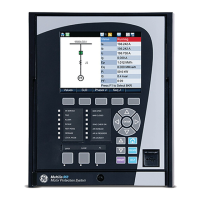4–138 869 MOTOR PROTECTION SYSTEM – INSTRUCTION MANUAL
PROTECTION CHAPTER 4: SETPOINTS
Current Unbalance
(46)
Unbalance current, also known as negative sequence current or I
2
, results in
disproportionate rotor heating. If the thermal overload protection’s unbalance bias feature
has been enabled (by setting non-zero value for the Unbalance Bias K Factor under
Setpoints > Protection > Group 1(6) > Motor > Thermal Model, the thermal overload
protection protects the motor against unbalance by tripping when the motor’s thermal
capacity is exhausted. However, the current unbalance protection can detect this
condition and alarm and /or trip before the motor has heated substantially. For the
869
relay, unbalance is defined as the ratio of negative-sequence to positive-sequence
current,
Eq. 26
where A
factor
is the adjustment factor used to prevent nuisance trip and/or alarm at light
loads.
If the motor is operating at an average current level (I
avg
) equal to or greater than the
programmed full load current (FLA, as selected by the Setpoints > System > Motor > Setup),
the adjustment factor (A
factor
) is one. However, if the motor is operating at an average
current level (I
avg
) less than FLA then the adjustment factor (A
factor
) is the ratio of average
current to full load current.
If this element is enabled, a trip and/or alarm occur(s) once the unbalance level equals or
exceeds the set pickup for the set period of time. If the unbalance level exceeds 40% (30%
when VFD Function is enabled and VFD is not bypassed), or when I
avg
≥ 25% FLA and
current in any one phase is less than the cutoff current, the motor is considered to be
single phasing and a trip occurs within 2 seconds. Single phasing protection is disabled if
the unbalance trip feature is “Disabled”.
NOTE:
Unusually high unbalance levels can be caused by incorrect phase CT wiring.
Path: Setpoints > Protection > Group 1(6) > Motor > Current Unbalance
TRIP FUNCTION
Range: Disabled, Trip, Configurable
Default: Disabled
This setting enables the Current Unbalance Trip functionality.
TRIP PICKUP
Range: 4.0 to 50.0% in steps of 0.1%
Default: 15%
The setting specifies a pickup threshold for the trip function. When setting the pickup
level, note that a 1% voltage unbalance typically translates into a 6% current
unbalance. To prevent nuisance trips or alarms, the pickup level must not be set too low.
Also, since short term unbalances are common, a reasonable delay must be set to avoid
nuisance trips or alarms. This setting must be greater than the corresponding setting for
the alarm stage.

